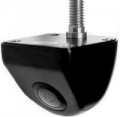Video resolution
The resolution of the frame taken by the camera in video mode, in pixels — in other words, the size of the picture in dots horizontally (first digit) and vertically (second digit). It should be taken into account here that in the case of reversing cameras, the recording in pixels describes only the frame on the camera matrix itself; to describe the "picture" coming to the connected screen, the designation in television lines (TVL) is used. This is due to the fact that the video signal is transmitted in an analogue format; See Video Resolution below for more on all of this. Here we note that with the same resolution in TVL and the same viewing angles, a camera with a higher resolution in pixels will produce a clearer, more detailed image. But
HD reversing cameras, and even more so
Full HD units.
Сolour encoding system
The colour system refers to the format in which colour information is transmitted in an analogue video signal. In modern reversing cameras, the European PAL system or the American NTSC are most often used. It makes no sense to describe them in detail — suffice it to say that for the normal operation of the camera you need a radio tape recorder (or other device with a screen on which the image is displayed) with support for the same colour system. However, incompatibility in this parameter is not fatal — with such a connection, the image will only turn from colour to black and white (in extreme cases, its overall quality will slightly deteriorate).
Signal-to-noise ratio
This parameter describes the total amount of interference in the video output from the camera. The higher the signal-to-noise ratio (that is, the ratio of the useful signal level to the level of extraneous interference) — the better the image will be, the less distortion it will have. The minimum level for modern cameras is considered to be 40 dB — with it, the “picture” is reproduced with minor noise that does not significantly affect its perception. And in the most advanced models, this figure can reach 48 – 50 dB — such an image for the human eye is almost indistinguishable from the perfect one.
Of course, in fact, the quality of the image also depends on the capabilities of the screen on which it is displayed, however, even the best screen will not save a “noisy” camera.
Min. illumination
The lowest ambient light level at which the camera can provide a normal image without additional illumination. In modern models, this indicator varies on average from 0.01 lux (clear night at a quarter moon) to 3 lux (deep twilight).
The lower the minimum illumination, the better the device handles with low light. However, note that in the absolute majority of cases, car cameras at night are used together with car lighting devices: front ones (see "View type") — with main headlights, rear ones — with reversing lights. Therefore, this parameter is rather general reference or even advertising information, rather than a really significant characteristic.

